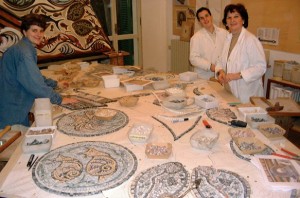
COURTESY CHURCH OF THE TRANSFIGURATION
Sister Agnes Whichard, left, with Alessandra Caprara in her studio in Ravenna, Italy working on a section of the floor mosaic for the Church of the Transfiguration.
ORLEANS – When Sister Agnes Whichard first viewed the famous mosaics in Ravenna, Italy, during a trip in 1996, she knew she had found a calling.
“I just absolutely had to learn how to do it. That was basically how it started. I just was smitten,” she said.
Whichard, 45, who is one of the artists at the Church of the Transfiguration at the Community of Jesus in Orleans, is in Italy this week working to complete a seven-foot tall, five-foot wide mosaic of the face of Jesus Christ that will be featured at the International Exhibit of Contemporary Sacred Art at the Basilica of San Lorenzo in Florence this October.
Even as she works to complete the major mosaic piece, Whichard, who moved to the Cape in 1989, said she is a kind of accidental artist.
“I just kind of stumbled into it. It wasn’t anything I thought about. It really was seeing the art in Ravenna that gave me a drive to learn more about it,” she said.
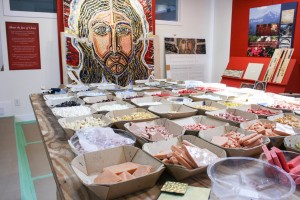
COURTESY CHURCH OF THE TRANSFIGURATION
Mosaic pieces are set up for work on face of Christ.
The original of the image is in the apse of the Church of the Transfiguration in Orleans.
Whichard said she likes the detailed work of making the colorful artwork. “It’s very methodical,” she said.
The floor mosaic that Whichard is working on, is done in marble, using about 100 colors.
“I was fascinated by the fact that there are that many colors made in nature that actually work for this,” she said.
The mosaic pieces are machine-cut to a certain size but to make them into the small sizes for the mosaic, they are hand-cut using an old fashioned type of hammer and a type of wedge called a “hardie.”
“I found that process very therapeutic in a sense, a peaceful process of watching the full mosaic take shape. It’s certainly not fast, but day after day a little bit more gets done. It’s just amazing to see it come together. That you, somehow, from these little pieces create a full piece of art that has strength and impact, to me was very satisfying and a big blessing to be able to participate in,” she said.
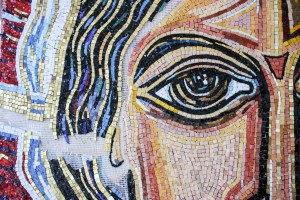
COURTESY CHURCH OF THE TRANSFIGURATION
Close-up of the mosaic depicting the face of Christ.
Mosaics are not the only sacred art in the Church of the Transfiguration. Besides mosaics, there are frescos, stone sculpture, stained glass and metal sculpture.
“It was many years in the process determining what art we wanted in the church,” Whichard said.
Early on when the leaders of the Church of the Transfiguration were trying to determine what style of architecture was suitable for their church, a group of church members had an opportunity to go over to Europe to look at different styles of architecture and art within the buildings.
Whichard was along on for one of those trips, which is how she ended up seeing the early Christian mosaics in Ravenna that had such an impact on her.
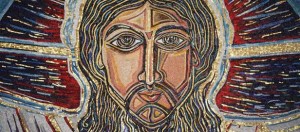
COURTESY CHURCH OF THE TRANSFIGURATION
The Church of the Transfiguration has an image of Christ in its apse. That image is being copied for an installation in Italy.
“The ones in Ravenna are as early as 329 [a.d.] and they still are stunning and they still have such a huge impact. I thought, this is just incredible that people way back then could produce such meaningful art that has stood the test of time,” she said.
The church leaders wanted the Church of the Transfiguration to be a “teaching” church, teaching various lessons and stories from the Bible, Whichard said.
They worked to figure out which images should go in the space, what art and iconography to use in the church. Different parts of the church depict different themes from the Bible or different symbols that have to do with the Bible and Christianity, Whichard explained.
“They wanted to use a lot of the traditional art forms that are found in a lot of the early churches,”Whichard said.
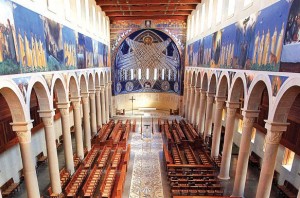
COURTESY CHURCH OF THE TRANSFIGURATION
An aerial view of the interior of the Church of the Transfiguration in Orleans includes extensive sacred artwork.
In 1997, the church brought over mosaicist Alessandra Caprara to teach three Community of Jesus members the main methods for doing mosaics.
Caprara, a native of Ravenna, trained at the Ravenna School of Mosaics, which specializes in the Byzantine Method, one of the oldest methods of mosaics.
There are multiple methods of mosaic work, depending on which surface the mosaic is going on, Whichard explained.
Caprara traveled to Cape Cod four times to teach mosaics classes to the group at the Community of Jesus.
But the training did not end there.
Whichard traveled to Italy three times to study with Caprara in Ravenna as part of her training as a mosaicist.
In 2002, the new guild of artists at the Church of the Transfiguration took on the Pastorium floor as their first large project. In the apse, they also made a mosaic of the face of Christ, designed by Helen McLean of Wexford, Ireland.
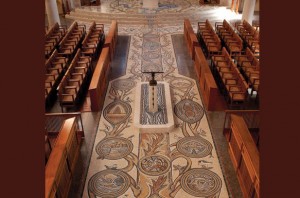
COURTESY OF THE CHURCH OF THE TRANSFIGURATION
A view of the mosaics on the floor of the nave at the Church of the Transfiguration.
That mosaic was installed in 2005.
“The apse was 275 pieces, so it was like a giant jigsaw puzzle that you had to systematically, piece by piece, put together and then the place where the two pieces meet, you have to hand-fill that in with mosaics,” Whichard said.
Whichard was one of a group from the church who traveled to Ravenna to fabricate the church’s floor and apse, which were then transported back to the US where Caprara helped them to be installed in the church in Orleans.
The new work being completed for the International Exhibit will take the opposite route, with work beginning in Orleans and then being completed in Italy.
Whichard and others began working on the new face of Christ mosaic in Orleans. but because it will be such a large work, Whichard explained, it is too large to ship as one large piece of art. Instead, it has been shipped over to Italy in five smaller pieces.
Caprara lent her expertise to help the church guild figure out how to copy the work that is in the apse.
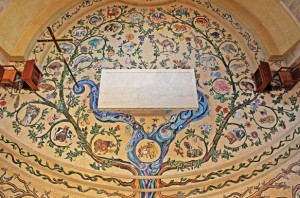
COURTESY CHURCH OF THE TRANSFIGURATION
A view of the mosaic on the sanctuary floor of the Church of the Transfiguration.
“She helps us know what you do and you don’t do when you’re making a copy of a work,” Whichard said. “You want to be true to the style and how the lines were done by the artist who did the original work. She’s trained us on what to look for and how to copy it effectively so it remains true to the original.”
To complete the work, Whichard will be working in Italy alongside Caprara at Via Sacra, home of the Mount Tabor Ecumenical Centre in Barga, Italy.
“We’ll cement those five pieces on a board and we’ve shipped over lots of “smalti,” which are the glass pieces that are used,” Whichard said.
Whichard will fill in the seams between each of the five pieces.
The completed piece will then be transported to Florence, Italy, where it will be part of a exhibit that opens in the fall at the National Bishops conference. The mosaic will be installed in San Lorenzo the last week in September and the exhibit opens on October 9.
After the exhibit, it will be transported back to Mount Tabor Ecumenical Center in Barga where it will stay.
To see the original mosaic work of the face of Christ in the apse at the Church of the Transconfiguration in Orleans, the church is open for tours of the art work, including the sculpture, the frescos, metalwork, glasswork and, of course, the mosaics.
Guided tours are offered Monday and Tuesday and Thursday to Saturday 10 a.m. to 5 p.m.
By LAURA M. RECKFORD, CapeCod.com NewsCenter








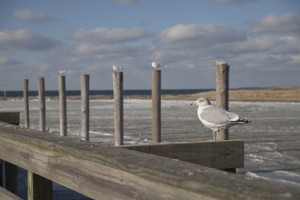
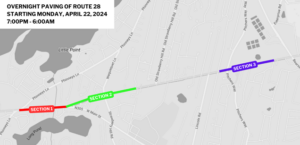

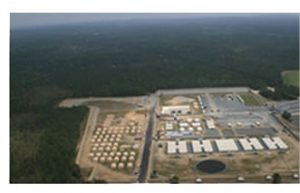













Speak Your Mind